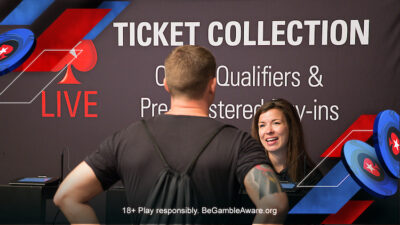The buzz is building around Jonathan Little‘s forthcoming poker strategy book, Jonathan Little’s Excelling at Tough No-Limit Hold’em Games, due next month from D&B Poker.
For the book Little gathered together a team of poker pros to share their hold’em wisdom in a series of illuminating strategy discussions. The book especially targets players who have some experience but who also have ambitions to move up in stakes.
According to Nate Silver of FiveThirtyEight.com, the book “smartly covers how to implement both GTO and exploitative strategies in thorny spots that come up all the time but haven’t gotten much attention from other books.”
Little’s 10 co-authors are all coaches with the backing company pocarr.com that also provides a comprehensive training site. Their students have enjoyed immense success in the World Championship of Online Poker and Spring Championship of Online Poker on PokerStars, and they bring their knowledge to readers wishing to do the same.
Excelling at Tough No-Limit Hold’em Games covers a number of topics related to the specific skill set players need to develop in order to move up from the lower stakes. Topics covered include:
- Quick tips for beating the low stakes games
- Adjusting your preflop strategy
- When to c-bet (continuation bet)
- How to defend against c-bets
- Navigating multi-way pots
- Basic ICM (Independent Chip Model) and advanced ICM
- Medium stacked final table strategies
- Strategies to crush live poker
What follows is an excerpt from Ben Shuster‘s contribution, titled “Passive Exploits to Crush the Small Stakes.”
Originally from the United States where Shuster earned a degree in management from The Walker College of Business at Appalachian State University, he now resides with his family in the Czech Republic where he poker player and coach for pocarr.com.
In the excerpt below, Shuster provides some concrete advice for exploiting players in small stakes games not by using aggression, but rather by employing a passive style.
from “Passive Exploits to Crush the Small Stakes” by Ben Shuster
Since most players start at the small stakes, let’s take a look at a few exploitative plays that you can passively make against the small stakes player pool in order to increase your edge. These exploits should be used against recreational players, which will be the majority of players in the $1 to $10 buy-in games. While all players play differently, if your default strategy passively exploits most of the opponents you play against, you will win more money than if your default strategy is the GTO strategy. This is because the GTO strategy does not adjust to what your opponents do incorrectly.
Of course, each specific player uses a different strategy, so pay attention and use your heads-up display to be sure you make the proper adjustments against your specific opponents. As you move up in stakes, many of these exploits will continue to work only against the weaker players. They will not work so well against the overall high stakes player pool, which will consist of mostly professional players rather than mostly recreational players.
The exploits in this chapter are based on my and the other Pocarr managers’ analyses of countless hand samples and reports from our backees. Having access to loads of data allows us to make informed adjustments against players at various stakes. While your individual experience is certainly relevant, having the experience of hundreds of players gives a much clearer picture of what is actually going on.
For the most part, players in small stakes games are generally passive and are not capable of sophisticated bluffs. Most of them only think about their own two cards and are not too concerned with their range, your range, or your overall strategy. This often results in their ranges being heavily tilted towards value when a lot of money goes in the pot, because they bet when they have what they think is the best hand and check when they don’t. It sounds overly simplistic, but this is how most recreational small stakes players play. Some of these exploits may seem like common sense to you, but even some winning players fail to use these exploits on a regular basis.
Preflop
Fold More Often Against 3-bets
When a passive opponent 3-bets, they usually have a strong hand. Against a strong range, you should fold the majority of your speculative hands, especially as the 3-bet size becomes larger. While you should often defend against 3-bets with a wide range against a loose polarized strategy (consisting of the best hands and some hands that are not quite good enough to call) that strong players use, against a premium linear range (consisting of only the best hands), you should proceed with caution.
Pay attention to position. When you raise from first position and the play- er in second position 3-bets, they probably have a premium hand. You should easily fold hands that are often dominated like A-Jo. However, if you raise from the cutoff and they 3-bet from the button, you should be much more inclined to stick around because they may know that they should 3-bet decently wide from the button against a cutoff raise, leaving A-Jo in decent shape.
Data generated by my co-author Richard ChipsFool Hoadley shows that small stakes players 3-bet against early position raises at all stack depths with roughly 4% of hands, which is only 10-10+, A-Js+, and A-Ko. Against that range, you need an abnormally strong hand to continue. Against middle position raisers, they 3-bet with about 6% of hands, which adds perhaps 9-9, 8-8, 7-7 and A-Qo. This is still an incredibly strong range. Against lojack and hijack raisers, they 3-bet with 7% of hands, adding perhaps A-10s and K-Qs. Against a cutoff raiser, they 3-bet with about 9% of hands, adding A-Jo, K-Qo and K-Js. Against these strong ranges, your exploit is to simply fold all your marginal hands that are not getting the correct pot odds or implied odds to call.
Make sure you leave your ego out of poker. Just because someone 3-bets you twice in a row does not mean they are trying to show you how great they are or push you around. The other players at the table are not going to think you are weak if you fold twice. In reality, the 3-bettor probably woke up with a strong hand two times in a row and made their default play of 3-betting with their strong hands. Your ego has no place at the poker table.
Over-fold Against 4-bets
When a passive player 4-bets, you can be sure they have an effective nut hand. While some recreational players may be aware that they should 4-bet with some blocker bluffs like A-5s or K-Qo every once in a while, almost none of them actually do it. They instead 4-bet with their effective nut hands, which usually end up being Q-Q+ and A-K. Against that range, you simply have to get out of the way with all but the absolute best hands. 10-10 and A-Qo are normally strong, but they are in bad shape against a passive player’s 4-bet.
Call Shoves Tighter
You should call the all-in shoves of passive players tighter than the GTO strategy recommends. This is because most passive players shove tighter than the GTO strategy, and are often not even aware of what the GTO strategy is. Even when everyone folds to the passive player in the small blind, they will fold far too often. This allows you to call tighter than the GTO strategy when they go all-in. Remember, when these players put a lot of chips in the pot, it is usually because they have a strong hand, not because they are looking to get out of line against you or because they are playing the GTO strategy.
As an example of this, suppose everyone folds to the cutoff who goes all-in for 12bbs, and then everyone folds to you in the big blind. If your opponent is playing optimally, you should call off with hands like K-8o and J-9s, but these are horribly losing calls against the average small stakes player. Against the average, slightly too tight small stakes player who shoves with roughly 30% of hands from the cutoff for 12bbs, you should instead call off with 2-2+, A-2s+, A-5o+, K-9s+, K-10o+ and Q-10s+. Everything else should be folded. If they shove even tighter than 30% of hands, your calling range should further adjust.
Call Wider Against Small Bets and Raises
Some of your passive opponents will make the mistake of betting and raising much too small when they happen to have a strong hand. An example that occurs frequently is when everyone folds to the small blind who min-raises, giving you excellent pot odds to call from the big blind. In position getting 4-to-1 pot odds, you can defend with essentially any two cards, even against a presumably strong range. A classic mistake some recreational players make is to 3-bet the minimum with A-A, hoping to keep you in the pot. This is an awful strategy because when you have to call 1bb more into a 7bb pot, you should call with almost everything due to your excellent implied odds against your opponent’s face-up hand. Just be sure you don’t pay them off poorly postflop! Many recreational players also make the mistake of 4-betting too small, allow- ing you to stick around with a wide range, assuming you are deep enough to still have decent implied odds.
When you are getting excellent pot odds plus implied odds, you should stick around with a wide range. Just be sure you navigate postflop well, which often means folding out marginal made hands like top pair to flop and turn aggression.
Over-fold Against Aggression in ICM Situations
When there are payout implications, especially when the recreational player is risking going broke, it is safe to assume they are not getting out of line. These players will guard their stack at the final table as if it is their only child. They did not navigate through a 1,000-person field just to bluff off their stack with six players remaining! They will not 3-bet with a polarized range including a lot of blocker bluffs and they will essentially never 4-bet all-in without an effective nut hand. When they put their stack in the pot in a high-risk situation, you can be quite sure they are not running an elaborate bluff.
Jonathan Little’s Excelling at Tough No-Limit Hold’em Games is available for pre-order in paperback or as an e-book from D&B Poker.
D&B Publishing (using the imprint D&B Poker) was created by Dan Addelman and Byron Jacobs 15 years ago. Since then it has become one of the leading publishers of poker books with titles by Phil Hellmuth, Jonathan Little, Mike Sexton, Chris Moorman, Dr. Patricia Cardner, Lance Bradley, Martin Harris and more, all of which are available at D&B Poker.








